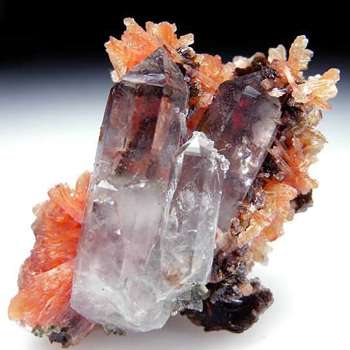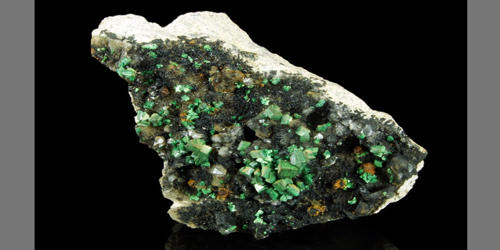The mineral hubeite, Ca2Mn2+Fe3+[Si4O12(OH)]·(H2O)2, is a sorosilicate of the Si4O13 group. It is a triclinic-pinacoidal mineral containing aluminum, calcium, hydrogen, iron, manganese, oxygen, and silicon. Structurally it also belongs to the Akatoreite group. It was found and named after the province of Hubei, China. It is common to iron ores in a mine of that region.
It occurs there as dark to pale brown bladed and elongate crystals in aggregates in association with inesite, apophyllite, and quartz in a wollastonite skarn. It may occur as isolated aggregates of crystals perched on white quartz, or it may occur covering both sides of thick specimens, that are usually pink inesite and apophyllite.
General Information
- Category: Sorosilicate
- Formula: Ca2Mn2+Fe3+[Si4O12(OH)]·(H2O)2
- Crystal system: Triclinic
- Crystal class: Pinacoidal (1) (same H-M symbol)

Fig: mineral hubeite
Properties
It occurs mainly as aggregates of fan-like crystals. It is dark to pale brown, has an orange-brown streak and is vitreous. Hubeite has a hardness of 5.5 in the Mohs scale, one good cleavage, and conchoidal fracture. The structure of hubeite is very uncommon, and in fact, there is only one other mineral that fits the Si4O13 group, which is ruizite.
- Color: Dark to pale brown
- Crystal habit: Aggregates of inter-grown crystals
- Fracture: Conchoidal fracture
- Tenacity: Brittle
- Mohs scale hardness: 5.5
- Luster: Vitreous
- Streak: Orange-brown
- Specific gravity: 3.02
Occurrence
Hubeite was discovered by Hawthorne et al. (2002) at the Daye mines in the Hubei province of China. It is classified as a sorosilicate, based on its formula. Other related minerals would be inesite, ruizite, and Akatoreite.
Hubeite is mainly associated to a skarn assemblage with pink inesite, colorless apophyllite, quartz, pyrite and colorless-white calcite. They all occur together at the Daye Mine. Usually, hubeite appears in two different situations.
Information Source:
















